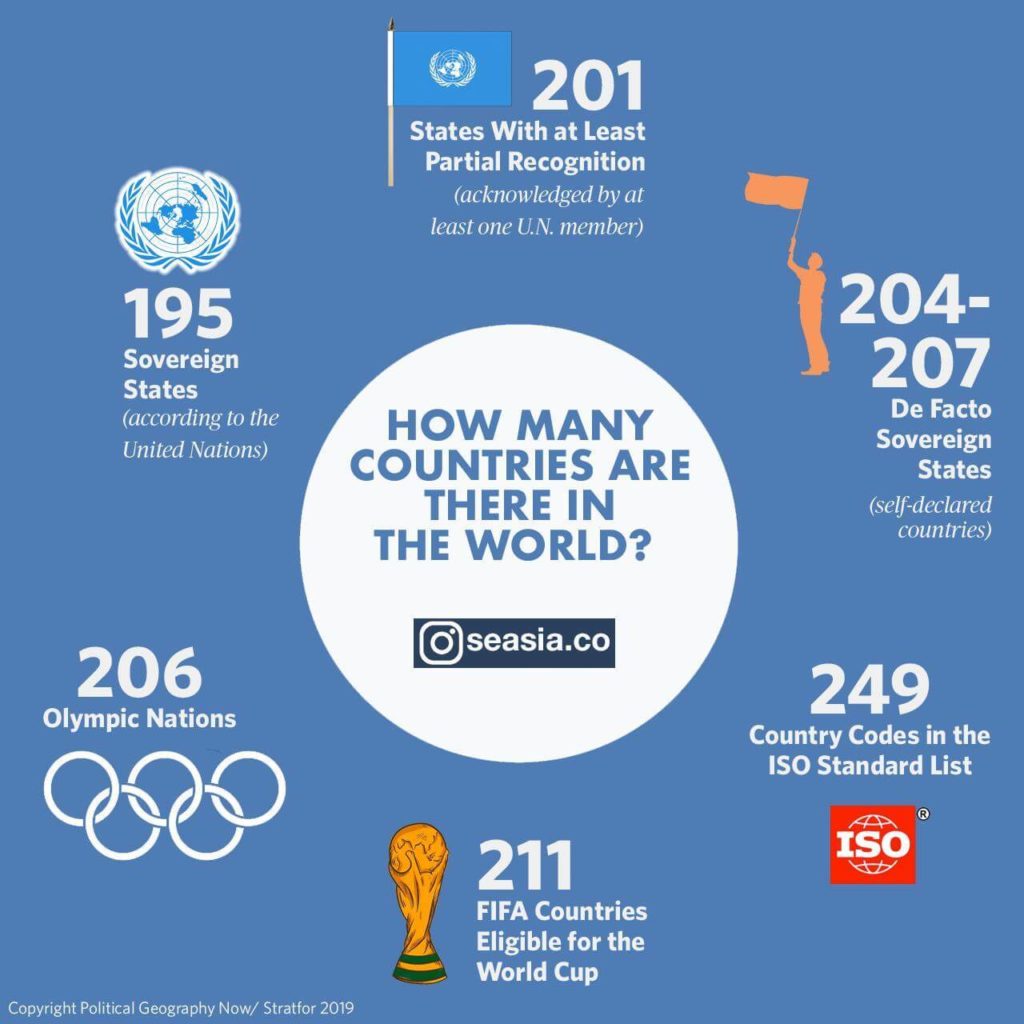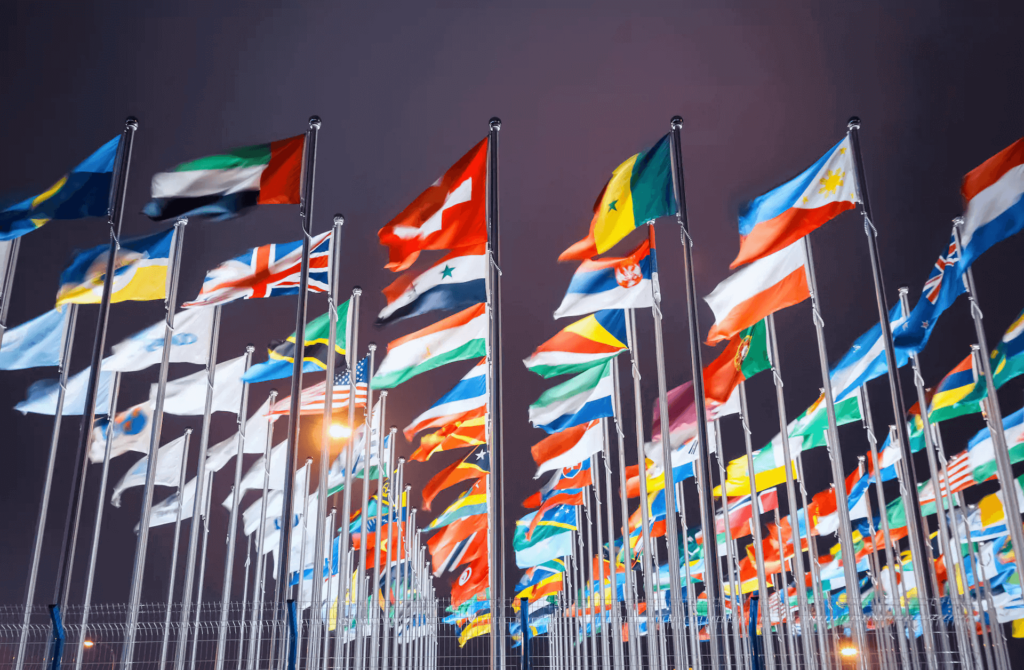How many countries do we actually have today?
Thus, it is not a wonder that there are many states or countries which are not U.N. members. This is partly due to the unclear international recognition procedure where the establishment of a new nation-state is concerned and criterion to become a sovereign state is somewhat not governed by concrete international law.

According to World Population Review in its report “Countries Not In The UN 2020” wrote: “The Holy See (Vatican) and Palestine are recognized as independent states by the UN and its members (but they are not members and just observers); however, some states are not recognized by the UN, although some members do recognize them as independent states.”
These states are Kosovo (recognized by 102 members); Taiwan (recognized by 16 members); Western Sahara (recognized by 44 members); South Ossetia (recognized by 5 members); Abkhazia (recognized by 5 members); and Northern Cyprus (recognized by 1 member).
As such the following categorization came into existence. According to Wikipedia, they are:
- UN member states which at least one other UN member state does not recognize
- Non-UN member states and observer states recognized by at least one UN member state
- Non-UN member states recognized by other non-UN member states only
- Non-UN member state not recognized by any state
A more detailed categorization is made by Stratfor in its report “How Many Countries Are There in the World in 2019?”, in which various different counts were made depending on the criteria accepted and the quarters making the data collection as below.
- 195 Sovereign States According to the UN. 193 UN members and 2 observer states, Palestine and Vatican, making a total of 195.
- 201 States With at Least Partial Recognition. 193 UN members, 2 observer states, and 6 states with partial recognition, making a total of 201.
- 204-207 De Facto Sovereign States. 193 UN members, 2 observer states, 6 states with partial recognition, and 3 to 6 Unrecognized de facto sovereign states, making a total of 204 to 207.
- 206 Olympic Nations. 193 Olympic nations that are UN member states, 1 Olympic nation that has UN observer state status, 2 Olympic nations that are partially-recognized states, 10 Olympic nations that are dependent territories, making a total of 206 International Olympic Committee (IOC)-recognized Olympic nations.
- 211 International Federation of Association Football (FIFA) Countries Eligible for the World Cup. 186 Teams of UN member states, 1 Team of UN observer state, 2 Teams of partially-recognized states, 4 Teams of U.K. constituent countries, and 18 Teams of dependent territories, making a total of 211 FIFA member associations.
- 249 Country Codes in the International Organization for Standardization (ISO) Standard List. International standard “country code” list, formally known as ISO 3166-1 includes 193 UN members, 2 UN observer states, 2 States with partial recognition, 45 Inhabited dependent territories, 6 Uninhabited territories, and 1 Antarctica, making a total of 249.
And if you add up 91 non-state nations from the UNPO list (97 including present and former members, with 6 already achieved nation-state status and became UN member states), the actual wanna-be nation-state count will be 340.

The making of statehood
“There is no definition that is binding on all the members of the community of nations on the criteria for statehood. In actual practice, the criteria are mainly political, not legal,” according to Wikipedia quoting source from B. Broms, “IV Recognition of States”, pp 47-48 in International law: achievements and prospects, UNESCO Series, Mohammed Bedjaoui(ed), Martinus Nijhoff Publishers, 1991.
In international law, however, there are several theories of when a state should be recognized as sovereign. Constitutive and declarative are two leading theories in international relation where recognition of a new state is concerned.
“Introduction In international law, the two most common schools of thought for the creation of statehood are the constitutive and declaratory theories of state creation. The constitutive theory was the standard nineteenth-century model of statehood, and the declaratory theory was developed in the twentieth century to address shortcomings of the constitutive theory. In the constitutive theory, a state exists exclusively via recognition by other states. The theory splits on whether this recognition requires “diplomatic recognition” or merely “recognition of existence””. (Source: Declaratory and Constitutive Theories of State. Retrieved from www.lawteacher.net).
According to Wikipedia:
“The constitutive theory of statehood defines a state as a person of international law if, and only if, it is recognized as sovereign by at least one other state. This theory of recognition was developed in the 19th century. Under it, a state was sovereign if another sovereign state recognized it as such.”
“By contrast, the declarative theory of statehood defines a state as a person in international law if it meets the following criteria: 1) a defined territory; 2) a permanent population; 3) a government and 4) a capacity to enter into relations with other states. According to declarative theory, an entity’s statehood is independent of its recognition by other states, as long as the sovereignty was not gained by military force. The declarative model was most famously expressed in the 1933 Montevideo Convention.”
However, the further development of declarative theory is explained by “Declaratory and Constitutive Theories of State” in www.lawteacher.net as:
“(T)he Montevideo criteria of statehood are rather minimal in scope and even then substantial controversy surrounds their application and interpretation. Suggestions for raising the bar for statehood and infusing the concept with additional normative criteria along these lines have in recent years included a widening range of requirements. These include the suggestions — which have drawn varying degrees of support in terms of international law — that a new state be: self-determining; democratic; established through peaceful means, legally, and by a negotiated settlement; independent; an observer of minority rights; be willing and able to observe international law; and “effective” with respect to the governance of the populations it contains.”

De facto and de jure recognition
The recognition of a state normally involved both de facto and de jure, although there were exceptions.
In “Recognition of a State under International Law” written by Subodh Asthana on June 15, 2019 (iPleader Blog spot) explained the recognition of de facto and de jure as follows:
“De facto recognition is a provisional recognition of statehood. It is a primary step to de jure recognition. It is a temporary and factual recognition as a state, and it can either be conditional or without any condition.”
“This mode recognition is granted when a new state holds a sufficient territory and control over a particular territory, but the other existing states consider that it does not have enough stability or any other unsettling issues. So, we can consider it as a test of control for newly formed states. De facto recognition is a process of acknowledging a new state by a non-committal act.”
“De jure recognition is the recognition of a new state by the existing state when they consider that the new state fulfills all the essential characteristics of a state. The de jure recognition can be granted either with or without granting de facto recognition. This mode of recognition is granted when the newly formed state acquires permanent stability and statehood. The de jure mode of recognition grants the permanent status of a newborn state as a sovereign state.”
However, “de jure states are sometimes recognized as being the legitimate government of a territory over which they have no actual control. For example, during the Second World War, governments-in-exile of a number of states continued to enjoy diplomatic relations with the Allies, notwithstanding that their countries were under occupation by Axis powers. The PLO and Palestinian Authority claim that the State of Palestine is a sovereign state, a claim which has been recognized by most states, though most of the territory it claims is under the de facto control of Israel,” according to the Wikipedia.
# End of Part III
(Part IV Conclusion will look into the EAO controlled territories and assess the situation whether secession and confederacy aspirations can be achieved within the present mold of international system.)



